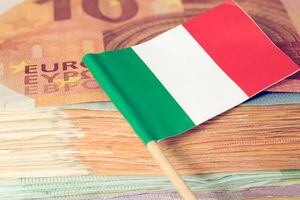Mistakes are easy, incompetence is permanent
There are lessons to be learned from Italy’s decades of economic stagnation, says Andy Sloan

I’M away from the island for the summer on an extended break. I’m writing from a country where the yield on 10-year government debt has doubled during 2022, a country whose prime minister has recently resigned and where many commentators are expressing concerns with its prospects for long-run sustainable economic growth.
No, not the UK. Top marks if you guessed Italy.
We’re spending the summer here courtesy of our cleaners, who caused our shower to flood the kitchen and so we had to move out while the floor is up being repaired. We’re AirBnBing this year but we have just bought a place out here because we have family here and it’s a great place to be during the summer.
Italy’s just a wonderful place. We love it.
It’s also an interesting country to make economic comparisons with the UK. It’s GDP per capita is some 20% lower than that of Blighty. Which is the reverse of the situation in the late ’70s when it was 20% bigger. Back then it was quite an industrial power, high tech manufacturing and strong car industry (remember the Fiat Strada adverts, anyone?). But clearly things haven’t quite swung their way during the last 40 years. Interesting to ponder.
Italy, together with France and Germany, experienced the post-war ‘Il miracolo economico’, ‘Les trente glorieuse’ or ‘Wirtschaftswunder’, the economic regeneration after the Second World War. Huge demand stimulus catalysed by the Marshall plan and major structural supply-side change catalysed by the common market.
The UK missed out and our jealousy of this economic out-performance was a major factor in wanting to join the common market. I recall being embarrassed as a schoolboy to discover Italy’s economic strength compared with the sick man of Europe, as Blighty was known back then.
You can see the results of this period all around the Italian countryside, where much of the housing and roads were built or rebuilt during the ’60s and ’70s. Not much since though – the roads in the Sabine mountains outside Rome where we’re staying are ‘interesting’.
So after the oil price shock of the ’70s, and the Thatcher-Reagan revolution of the early ’80s, what happened to Italy to reverse its economic fortunes over the next 40 years?
Growth in the decade of Pat Sharp and the mullet was put paid to by undermining of the rule of law, political instability and corporate corruption. Mafia car bombings and regular assassinations of judges of the period were unhelpful, as was the strength of the Italian communists and their closeness to Moscow. It’s all history book stuff.
Three decades of appallingly poor monetary policy then baked in the stagnation: shadowing the Deutschmark and membership of the ERM (Italy was the other sovereign ejected on Black Wednesday, but soon rejoined) and then 20 years of the single currency.
To summarise, supply-side and monetary sclerosis.
And the economy has been kept going by ECB largesse ever since Super Mario vowed to do ‘whatever it took’ to save the euro. His successor, Christine Lagarde, is clearly loath to take away the crutch of easy money, launching the Transmission Protection Instrument, AKA the Keep On Buying Italian Debt Instrument, while announcing last week’s rate rise. I’ll return to discussing this instrument in next month’s column as the International Sustainability Institute Channel Islands will soon be publishing a short paper on monetary policy as the root of current economic and pressures on offshore finance. I might even include an award for worst central banker of the last decade.
Italian banks are notoriously insolvent, so there’s no bank lending, so young people and families can’t borrow. The housing market is therefore dead. Yet there’s a surplus of cheap property. In parallel, Covid stimulus is doled out in spades to pay for current property renovations, funded by government borrowing of Europe’s largest sovereign debtor. An unsustainable mix. I’ve said this before, the problem is that things can continue in an unsustainable fashion for a very, very long time. Call it Sloan’s law, Jim. Problems just keep building up.
None of this is apparent from my AirBnB lakeside terrace. Life feels good.
And you’re probably wondering what has this month’s economic history column got to do with Guernsey?
In Sloan’s economic world view, there are usually only a handful of really important factors behind successful economies and conversely only ever a handful of really important factors behind unsuccessful ones. Italy’s experience of three decades of positive supply-side and demand-side conditions was followed by negative hits to its supply-side and three decades of contractionary monetary policy. Hey presto! Explaining 70 years of economic performance in just a couple of paragraphs. So I think I can parse down the read-across for us in a similarly short fashion.
I bet you in Italy in 1979 people weren’t sitting around setting economic policy with the objective of 40 years of economic stagnation. But it happened. And it’s been very imperceptible for the last 15 years as the ECB has continued to bale out the country. But stagnate it has, mainly due to a few big-ticket mistakes and inaction on important issues. Italian experience was that European integration was a good thing, so unlike the Brits they drew the wrong lesson from being kicked out of the ERM. Staying in the European monetary project ironically then masked the sclerosis of its supply-side and corruption (because of the ECB’s largesse).

Guernsey had its own historic economic halcyon period. From the mid-seventies to mid-noughties offshore finance transformed the landscape. We then had our own decade of stagnation after the global financial crisis. Where we are now and what we do now could drive our economic direction for several decades.
We failed to notice the stagnation of the last decade at first because we missed the worst of the subsequent global downturn and thus missed out on the austerity experience. The same decade saw a spiralling of finance sector costs (during a non-inflationary decade) and a failure of policy makers to concern themselves with competitiveness (AKA supply-side issues). We then missed out on the worst ravages of Covid and are now racing through a post-pandemic bounce, so we’re missing the signals of stagnation again.
Our experience can blindside us to the underlying causes of problems, as it did the Italians.
My concern is that long-term solutions are being presented to short-term problems and vice versa, particularly in our housing market, where we seem to be suffering from the ‘Something must be done, this is something, therefore it must be done’ syndrome. After all, why build on an agricultural field forever to solve a short-term pressure of housing temporary workers? Why build new ‘affordable homes’ for single households on sites out of Town without facilities and transport? Indeed, why are we building affordable homes for single households as a priority anyway? Will these moves really solve the ‘housing crisis’?
I’ll sign off with a few words of advice for Mark de Garis, who I believe deservedly got the job as the new head of the States. When it comes to the economy, there are only a handful of factors to get right. Concentrate on just a few things. And be wary of hubris.
Our shared Guernsey experience is somewhat unique. But what is not unique is the ability of policy-makers to get it wrong. As the Italian experience demonstrates, it’s so easy to do.





